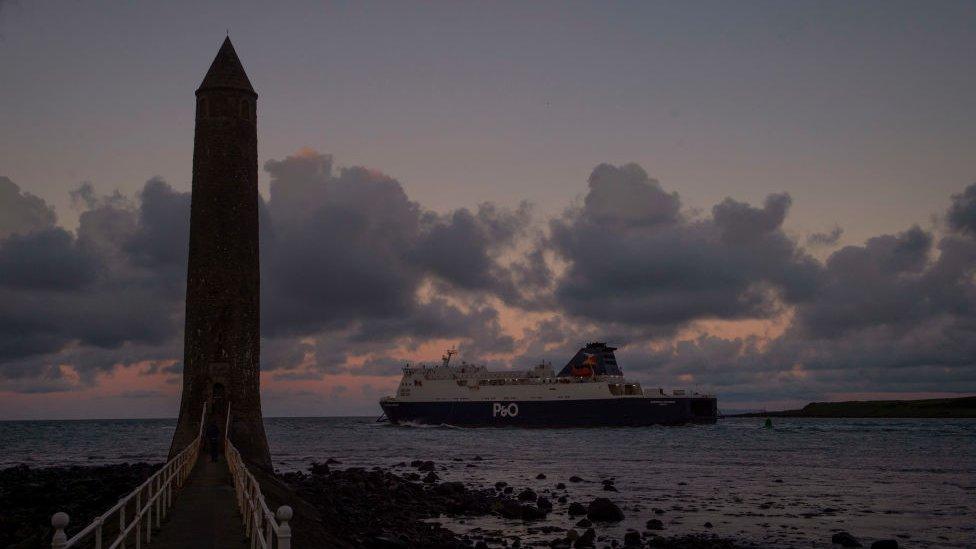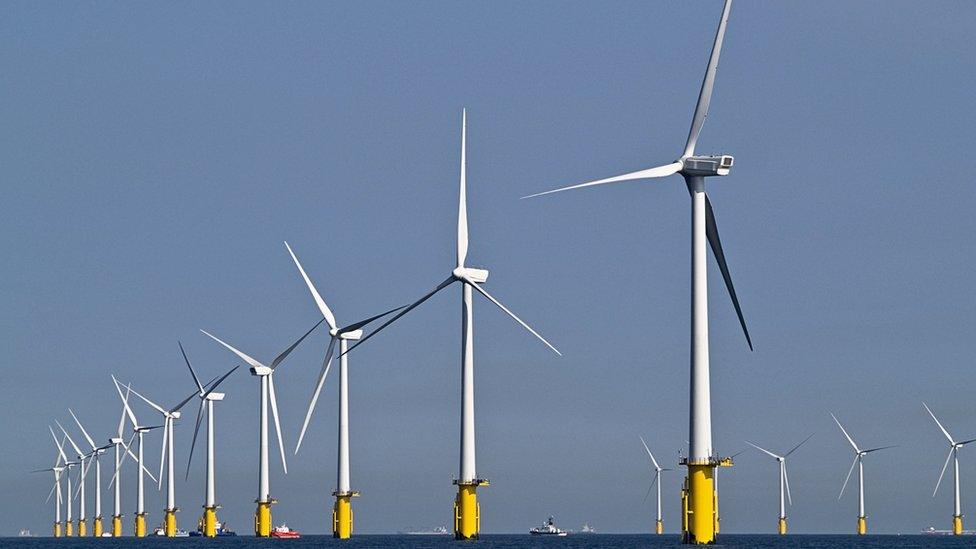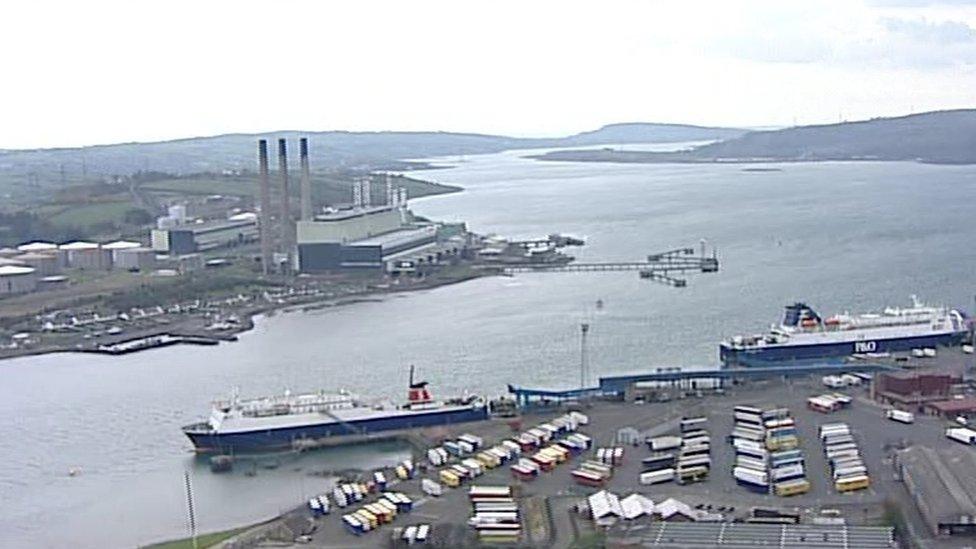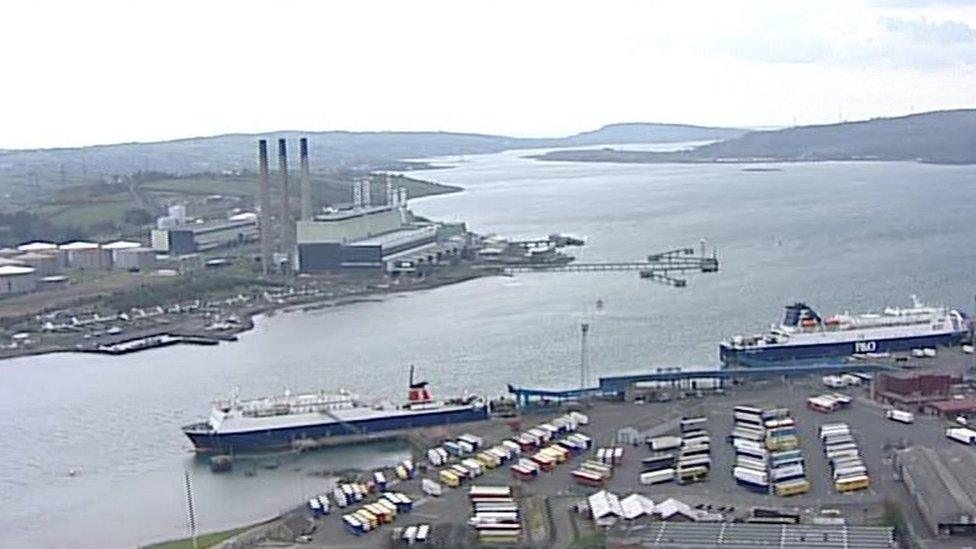Larne Lough gas storage caverns could aid net zero plan - study
- Published

The project would see caverns hollowed out under Larne Lough
The team behind a project to store gas in salt caverns near Islandmagee says a year-long study indicates a fully-green gas network in NI is possible.
The project would see seven large gas storage caverns hollowed out underneath Larne Lough.
The consortium behind it includes B9 Energy, Mutual Energy, Islandmagee Energy and the Net Zero Technology centre in Aberdeen.
There has been a judicial review challenge to the project.
It was launched by local campaigners and Friends of the Earth, who said it would damage marine life due to salt water being pumped out to create the caverns for storage.
The Ballylumford Power-to-X Phase One project was granted almost £1m by the former Department of Business, Energy and Industrial Strategy (BEIS), external to examine maximising wind power by storing excess generation as hydrogen.
That hydrogen can then be used to support the electricity network at times of low wind renewable power generation.
The consortium carried out the study as part of the Longer Duration Energy Storage Demonstration programme run by BEIS.
Data from the study showed the on-site production, storage and distribution of hydrogen, produced through electrolysis, is possible and could help Northern Ireland achieve its legally-binding net zero targets.
It involves using water to dissolve salt to create caverns for storage below Islandmagee, a process which would take about a year.
That extremely salty water would be pumped into the sea off the coast - something campaigners say will have a significant impact on priority species marine life and damage climate action goals.

Analysis: A difficult balancing act
There is no doubt Northern Ireland needs to make more of the renewable generation capacity it naturally has, mostly wind.
It has to be switched off when demand is low.
Storage would mean it could be released when needed, rather than lost, which would help meet our climate change targets.
Converting wind generation into hydrogen using renewably-powered electrolysis is environmentally friendly.
As the saying goes though, location is everything - the cavernous underground spaces below Islandmagee may be suited to storage, but the sea above is a protected area and home to important species.
It is a very difficult balancing act.

Consortium members say the scheme is essential for future energy security.
David Surplus, managing director of B9 Energy, said it would allow it to take full advantage of "home-grown renewable energy sources, drive down costs and help end our reliance on volatile, expensive fossil fuels".
"We've not only established the technical viability of having a 100% hydrogen transmission pipeline here, but also longer duration and higher capacity storage options to help bolster regular energy supplies across NI," he added.
"We've also created the design and specification of electrolysers and gas blending panel technologies.
"A fully green hydrogen economy is possible, but now we need actions to make it happen and that will depend on more collaboration between government, regulators and the transport and energy sectors."
Judith Tweed, director of Islandmagee Energy, said the scheme would work with offshore wind projects.
"Large offshore wind projects are ideally suited to our coastline," she said.
"The production of green hydrogen from excess wind power will balance intermittent generation with existing energy demand patterns - delivering a more secure and sustainable energy for the future."

Judith Tweed, director of Islandmagee Energy, said the scheme would work with offshore wind projects
Northern Ireland now has a target of 80% renewable energy by 2030.
The financial director at Mutual Energy, Gerald McIlroy, said hydrogen would be essential to meet that.
"Hydrogen will play an important role in the decarbonisation of the Northern Ireland economy and maintaining robust security of energy supply for consumers here," he added.
"Collaboration between industry and government will be key to delivering the energy transition and it is vital that policy is developed in a way that allows the potential of the hydrogen economy to be realised."
Craig Nicol from the Net Zero Technology Centre said the proposal would support jobs.
"The manufacture, assembly and maintenance of wind farms and electrolysers will create job opportunities and future export potential as Europe invests to meet its net zero ambitions and respond to the current energy market challenges."
Related topics
- Published4 April 2022

- Published13 October 2021

- Published6 February 2020
